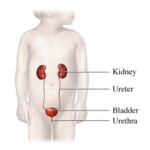UTI
Urinary tract infection (UTI) in children is quite common and surprisingly not diagnosed most often. UTI occurs both in normal children and in those with some urinary tract abnormality. The reason so much of importance is laid on the diagnosis and management of this problem, is because, unlike other diseases, infants who have urinary infection may not have any symptoms pertaining to the urinary tract at all.
How common is the problem?
As many as 6% of girls and 2% of boys will develop a UTI.
What are the symptoms of UTI in children?
The common belief with most parents is that with urinary infection, the child should present with burning in the urine, blood in the urine, difficulty in passing urine, and so on. This is common presentation in adults. But in children these are rarely true. Less than one year of age, they may present simply with fever, not feeding well, loose stools, vomiting etc., Unless one has a high index of suspicion about the presence of a UTI, it can be missed.
What causes UTI in children?
Infection commonly occurs as a result of bacteria ascending from the genital area. Girls have a higher incidence in their early years because of the short urethra. There may be numerous other causes contributing to be incidence of infection, in which either the flow of urine down from the kidney may be blocked at different levels, or the normal flow of urine out of the bladder is disturbed, with urine going backwards into the kidney.
How is UTI diagnosed in children?
Those children, who have fever of unknown cause, must have a urine test done. It costs very little even in a private clinic, and will give a very good indication if urinary infection is present. Once urine infection has been detected, all children must undergo further tests like an urine culture, ultrasound evaluation, an MCU (Micturating cystourethrogram) X-ray to find out abnormality in urinary tract, and decide on treatment. Additional tests include nuclear scans which are a special type of imaging of the kidneys to look for any evidence of scarring. In this a small amount of radio-isotope tracer is injected in the arm vein. The isotope will be taken up by the kidneys and scan will give information about kidney function and also presence of any scars.
How is UTI treated in children?
UTI is treated with antibiotics. After giving urine culture, your doctor will choose an antibiotic drug which has to be taken either orally or intravenous route. Based on the culture report, which comes usually after 48 hours, the antibiotic may be changed. The course of antibiotic will be decided by your doctor and may be given up to 2 weeks.
Can UTI be prevented?
Certain habits are useful to prevent recurrent urinary tract infection if a normal urinary tract is found on evaluation. Adjusting fluid intake to age and bladder capacity and frequent bladder emptying will help clear infection from the bladder. Avoiding constipation by a high fiber diet or medications is very important.
Do UTI have long term effects?
Young children are at significant risk for kidney damage due to urinary infection, kidney scarring occurs, which is the most serious long term result. This in turn leads to protein leak in the urine, high blood pressure and decreased kidney function. Those who have had infection very early in their life will have severe scars in the kidney.
The goal is the early detection of urinary tract abnormalities and prevention of kidney infection by either medical or surgical means. Long-term studies have shown a 10% incidence of kidney failure, 13% incidence of high blood pressure, and another 13% incidence of kidney related problems during pregnancy. When one considers that renal scarring is the fourth leading cause for renal transplantation in children, the need for prevention becomes obvious.

